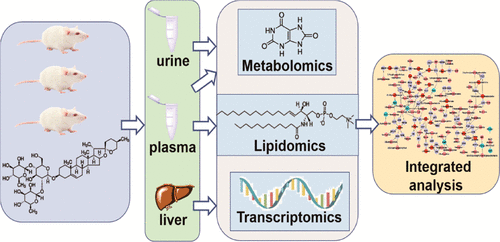当前位置:
X-MOL 学术
›
J. Proteome Res.
›
论文详情
Our official English website, www.x-mol.net, welcomes your
feedback! (Note: you will need to create a separate account there.)
Multiomics Integrative Analysis for Discovering the Potential Mechanism of Dioscin against Hyperuricemia Mice
Journal of Proteome Research ( IF 3.8 ) Pub Date : 2020-10-27 , DOI: 10.1021/acs.jproteome.0c00584 Yao Tan 1 , Liming Wang 1 , Jian Gao 1 , Junhong Ma 2 , Haiyang Yu 1 , Yi Zhang 1 , Tao Wang 1 , Lifeng Han 1
Journal of Proteome Research ( IF 3.8 ) Pub Date : 2020-10-27 , DOI: 10.1021/acs.jproteome.0c00584 Yao Tan 1 , Liming Wang 1 , Jian Gao 1 , Junhong Ma 2 , Haiyang Yu 1 , Yi Zhang 1 , Tao Wang 1 , Lifeng Han 1
Affiliation

|
Hyperuricemia is a well-known key risk factor for gout and can cause a variety of metabolic diseases. Several studies have shown that dioscin could improve metabolic symptoms and reduce the uric acid level in blood. However, there is no comprehensive metabolomic study on the anti-hyperuricemia effects of dioscin. A total of 29 adult male Kunming mice were divided into three groups: Normal (blank), PO (potassium oxonate-administrated, 200 mg/kg/day), and Dioscin (potassium oxonate + dioscin, potassium oxonate 200 mg/kg/day, dioscin 50 mg/kg/day). All mice were treated for 42 days via oral gavage. This paper implemented an untargeted metabolomics study based on 1H NMR and LC-MS to discover the comprehensive mechanism of dioscin. Furthermore, a targeted lipidomics was fulfilled to further analyze the lipid metabolism disorder. Finally, the metabolic pathway mediated by dioscin was verified at the gene level by means of transcriptomics. The results show 53 different metabolites were closely related to the improvement of dioscin in PO-induced hyperuricemia, and 19 of them were lipids. These metabolites are mainly involved in the tricarboxylic acid cycle, lipid metabolism, amino acid metabolism, and pyrimidine metabolism. According to the transcriptomics study, the levels of 89 genes were significantly changed in the PO group compared to the normal control. Among them, six gene levels were restored by the treatment of dioscin. The six changed genes (tx1b, Tsku, Tmem163, Psmc3ip, Tcap, Tbx15) are mainly involved in the cell cycle and energy metabolism. These metabolites and genes might provide useful information for further study of the therapeutic mechanism of dioscin.
中文翻译:

多元组学综合分析发现薯os皂甙元对高尿酸血症小鼠的潜在作用机制
高尿酸血症是众所周知的痛风的关键危险因素,可引起多种代谢性疾病。多项研究表明薯di皂素可以改善代谢症状并降低血液中的尿酸水平。但是,关于薯os皂素的抗高尿酸血症作用尚无全面的代谢组学研究。共有29只成年雄性昆明小鼠分为三组:正常(空白),PO(草酸钾给药,200 mg / kg /天)和薯os皂素(草酸钾+薯os皂素,草酸钾200 mg / kg /天) ,薯os皂素50 mg / kg /天)。通过管饲法将所有小鼠治疗42天。本文基于1进行了非靶向代谢组学研究1 H NMR和LC-MS发现薯os皂素的综合机理。此外,实现了靶向脂质组学,以进一步分析脂质代谢障碍。最后,通过转录组学在基因水平上验证了薯di皂苷介导的代谢途径。结果显示,PO引起的高尿酸血症中53种不同的代谢产物与薯os皂素的改善密切相关,其中19种为脂质。这些代谢物主要参与三羧酸循环,脂质代谢,氨基酸代谢和嘧啶代谢。根据转录组学研究,与正常对照组相比,PO组中89个基因的水平发生了显着变化。其中,通过薯os素可以恢复六个基因水平。六个变化的基因(tx1b,Tsku,Tmem163,Psmc3ip,Tcap,Tbx15)主要参与细胞周期和能量代谢。这些代谢物和基因可能为进一步研究薯os皂素的治疗机理提供有用的信息。
更新日期:2021-01-01
中文翻译:

多元组学综合分析发现薯os皂甙元对高尿酸血症小鼠的潜在作用机制
高尿酸血症是众所周知的痛风的关键危险因素,可引起多种代谢性疾病。多项研究表明薯di皂素可以改善代谢症状并降低血液中的尿酸水平。但是,关于薯os皂素的抗高尿酸血症作用尚无全面的代谢组学研究。共有29只成年雄性昆明小鼠分为三组:正常(空白),PO(草酸钾给药,200 mg / kg /天)和薯os皂素(草酸钾+薯os皂素,草酸钾200 mg / kg /天) ,薯os皂素50 mg / kg /天)。通过管饲法将所有小鼠治疗42天。本文基于1进行了非靶向代谢组学研究1 H NMR和LC-MS发现薯os皂素的综合机理。此外,实现了靶向脂质组学,以进一步分析脂质代谢障碍。最后,通过转录组学在基因水平上验证了薯di皂苷介导的代谢途径。结果显示,PO引起的高尿酸血症中53种不同的代谢产物与薯os皂素的改善密切相关,其中19种为脂质。这些代谢物主要参与三羧酸循环,脂质代谢,氨基酸代谢和嘧啶代谢。根据转录组学研究,与正常对照组相比,PO组中89个基因的水平发生了显着变化。其中,通过薯os素可以恢复六个基因水平。六个变化的基因(tx1b,Tsku,Tmem163,Psmc3ip,Tcap,Tbx15)主要参与细胞周期和能量代谢。这些代谢物和基因可能为进一步研究薯os皂素的治疗机理提供有用的信息。











































 京公网安备 11010802027423号
京公网安备 11010802027423号